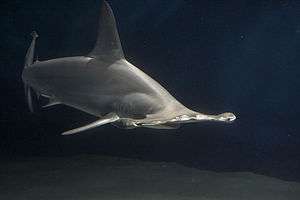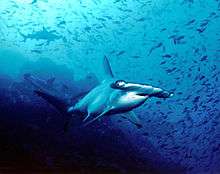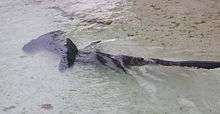Hammerhead shark
| Hammerhead sharks Temporal range: Middle Miocene to Present[1] | |
|---|---|
 | |
| Scalloped hammerhead, Sphyrna lewini | |
| Scientific classification | |
| Kingdom: | Animalia |
| Phylum: | Chordata |
| Class: | Chondrichthyes |
| Subclass: | Elasmobranchii |
| Superorder: | Selachimorpha |
| Order: | Carcharhiniformes |
| Family: | Sphyrnidae T. N. Gill, 1872 |
| Genera | |
 | |
The hammerhead sharks are a group of sharks in the family Sphyrnidae, so named for the unusual and distinctive structure of their heads, which are flattened and laterally extended into a "hammer" shape called a cephalofoil. Most hammerhead species are placed in the genus Sphyrna while the winghead shark is placed in its own genus, Eusphyra. Many not necessarily mutually exclusive functions have been proposed for the cephalofoil, including sensory reception, manoeuvering, and prey manipulation. Hammerheads are found worldwide in warmer waters along coastlines and continental shelves. Unlike most sharks, hammerheads usually swim in schools during the day, becoming solitary hunters at night. Some of these schools can be found near Malpelo Island in Colombia, Cocos Island off Costa Rica, and near Molokai in Hawaii. Large schools are also seen in the waters off southern and eastern Africa.
Description
The known species range from 0.9 to 6 m (3.0 to 19.7 ft) in length and weigh from 3 to 580 kg (6.6 to 1,278.7 lb).[2][3] They are usually light gray and have a greenish tint. Their bellies are white which allows them to blend into the ocean when viewed from the bottom and sneak up on their prey.[4] Their heads have lateral projections which give them a hammer-like shape.
Hammerheads have disproportionately small mouths and seem to do a lot of bottom-hunting. They are also known to form schools during the day, sometimes in groups of over 100. In the evening, like other sharks, they become solitary hunters. National Geographic explains that hammerheads can be found in warm tropical waters, but during the summer Hammerheads participate in a mass migration to search for cooler waters. [5]
Taxonomy and evolution
Since sharks do not have mineralized bones and rarely fossilize, it is their teeth alone that are commonly found as fossils. The hammerheads seem closely related to the carcharhinid sharks that evolved during the mid-Tertiary Period. According to DNA studies, the ancestor of the hammerheads probably lived in the Miocene epoch about 20 million years ago.[6]
Using mitochondrial DNA, a phylogenetic tree of the hammerhead sharks showed the winghead shark as its most basal member. As the winghead shark has proportionately the largest "hammer" of the hammerhead sharks, this suggests that the first ancestral hammerhead sharks also had large hammers.[7]
Cephalofoil
The theory has been advanced that the hammer-like shape of the head may have evolved (at least in part) to enhance the animal's vision.[8] The positioning of the eyes, mounted on the sides of the shark's distinctive hammer head, gives the shark good 360-degree vision in the vertical plane, meaning they can see above and below them at all times.[9][10] The shape of the head was previously thought to help the shark find food, aiding in close-quarters maneuverability and allowing sharp turning movement without losing stability. However, it has been found that the unusual structure of its vertebrae was instrumental in making the turns correctly, more often than the shape of its head, though it would also shift and provide lift. From what is known about the winghead shark, it would appear that the shape of the hammer-head has to do with an evolved sensory function. Like all sharks, hammerheads have electroreceptory sensory pores called ampullae of Lorenzini. By distributing the receptors over a wider area, like a larger radio antenna, hammerheads can sweep for prey more effectively.[11]
Reproduction
Reproduction occurs only once a year for hammerhead sharks, and usually occurs with the male shark biting the female shark violently until she agrees to mate with him.[12] The hammerhead sharks exhibit a viviparous mode of reproduction with females giving birth to live young. Like other sharks, fertilization is internal with the male transferring sperm to the female through one of two intromittent organs called claspers. The developing embryos are at first sustained by a yolk sac. When the supply of yolk is exhausted, the depleted yolk sac transforms into a structure analogous to a mammalian placenta (called a "yolk sac placenta" or "pseudoplacenta"), through which the mother delivers sustenance until birth. Once the baby sharks are born, they are not taken care of by the parents in any way. There is usually a litter of 12 to 15 pups; except for the Great Hammerhead which births litters of 20 to 40 pups. These baby sharks huddle together and swim toward warmer water until they are old enough and large enough to survive on their own.[12]
In 2007, the bonnethead shark was found to be capable of asexual reproduction via automictic parthenogenesis, in which a female's ovum fuses with a polar body to form a zygote without the need for a male. This was the first shark known to do this.[13]
Diet
Hammerhead sharks are known to eat a large range of prey including fish, squid, octopus, crustaceans, and other sharks. Stingrays are a particular favorite. These sharks are often found swimming along the bottom of the ocean, stalking their prey. Their unique head is used as a weapon when hunting down prey. The hammerhead shark uses its head to pin down stingrays and eats the ray when the ray is weak and in shock.[12] The great hammerhead, tending to be larger and more aggressive than most hammerheads, occasionally engages in cannibalism, eating other hammerhead sharks, including its own young.[14]
Species

| Species | Common names | IUCN status |
|---|---|---|
| Eusphyra blochii | Winghead shark | Near threatened[15] |
| Sphyrna corona | Scalloped bonnethead | Near threatened[16] |
| Sphyrna couardi | Whitefin hammerhead | Yet to be assessed[17] |
| Sphyrna gilberti | Carolina hammerhead | Yet to be assessed[18] |
| Sphyrna lewini | Scalloped hammerhead | Endangered[19] |
| Sphyrna media | Scoophead | Data deficient[20] |
| Sphyrna mokarran | Great hammerhead | Endangered[21] |
| Sphyrna tiburo | Bonnethead | Least concern[22] |
| Sphyrna tudes | Smalleye hammerhead | Vulnerable[23] |
| Sphyrna zygaena | Smooth hammerhead | Vulnerable[24] |
Relationship with humans

Of the nine known species of hammerhead, only three are known to be particularly dangerous to humans: the scalloped, great, and smooth hammerheads. As of 2013, 33 attacks have occurred with no fatalities.
The great and the scalloped hammerheads are listed on the World Conservation Union's (IUCN) 2008 Red List as endangered, whereas the smalleye hammerhead is listed as vulnerable. The status given to these sharks is as a result of overfishing and demand for their fins, an expensive delicacy. Among others, scientists expressed their concern about the plight of the scalloped hammerhead at the American Association for the Advancement of Science annual meeting in Boston, Massachusetts. The young swim mostly in shallow waters along shores all over the world to avoid predators.
Shark fins are prized as a delicacy in certain countries in Asia (such as China), and overfishing is putting many hammerhead sharks at risk of extinction. Fishermen who harvest the animals typically cut off the fins and toss the remainder of the fish, which is often still alive, back into the sea.[25] This practice, known as finning, is lethal to the shark.
In Native Hawaiian culture, sharks are considered to be gods of the sea, protectors of humans, and cleaners of excessive ocean life. Some of these sharks are believed to be family members who died and have been reincarnated into shark form. However, some sharks are considered man-eaters, also known as niuhi. These sharks include great white sharks, tiger sharks, and bull sharks. The hammerhead shark, also known as mano kihikihi, is not considered a man-eater or niuhi; it is considered to be one of the most respected sharks of the ocean, an aumakua. Many Hawaiian families believe that they have an aumakua watching over them and protecting them from the niuhi. The hammerhead shark is thought to be the birth animal of some children. Hawaiian children who are born with the hammerhead shark as an animal sign are believed to be warriors and are meant to sail the oceans. It is extremely rare for hammerhead sharks to pass through the waters of Maui, but many Maui natives believe that hammerhead sharks swimming by is a sign that the gods are watching over the families, and the oceans are clean and balanced.[26]
Hammerheads in captivity
Great hammerheads have been kept in captivity at several facilities, including Atlantis Paradise Island Resort (Bahamas), Adventure Aquarium (New Jersey), Georgia Aquarium (Atlanta), Mote Marine Laboratory (Florida), and the shark reef exhibit at Mandalay Bay (Las Vegas).[27] Aquarist Dean Trinh has successfully raised scalloped hammerhead pups, which he has claimed were collected by hand from an environment in which they might otherwise face the prospect of starvation. Other aquarists have noted the importance of providing adequate room for hammerheads to swim constantly and for the provision of mechanical filtration systems to maintain suitable water quality for shark survival.[28] In 2015, the proprietors of the nightclub Atlantis in Adelaide, South Australia, announced plans to keep two hammerhead sharks in a 3-metre (10 ft) diameter cylindrical tank on their premises.[29] The proposal prompted animal-rights activists to start a petition calling for the abandonment of the idea. The petition attracted 35,000 signatures in two weeks.[30]
Protection
In March 2013, three endangered commercially valuable sharks, the hammerheads, the oceanic whitetip, and porbeagle were added to Appendix II of CITES, bringing shark fishing and commerce of these species under licensing and regulation.[31]
See also
References
- ↑ Sepkoski, Jack (2002). "A compendium of fossil marine animal genera (Chondrichthyes entry)". Bulletins of American Paleontology. 364: 560. Retrieved January 9, 2008.
- ↑ Hessing, S. (2000). Sphyrna tiburo. Animal Diversity Web. Retrieved on 2012-12-19.
- ↑ "Record Hammerhead Pregnant With 55 Pups". Discovery News. Associated Press. July 1, 2006. Retrieved October 18, 2008.
- ↑ Hammerhead Shark. Sharks-world.com. Retrieved on 2012-12-19.
- ↑ "Hammerhead Shark". NationalGeographic.com. Retrieved November 9, 2016.
- ↑ "Hammerhead shark study shows cascade of evolution affected size, head shape". ScienceDaily.com. University of Colorado at Boulder. May 19, 2010. Retrieved November 9, 2016.
- ↑ Martin, R. Aidan. "Origin and Evolution of the 'Hammer'". elasmo-research.org. Retrieved January 31, 2005.
- ↑ McComb, D. M.; Tricas, T. C.; Kajiura, S. M. (2009). "Enhanced visual fields in hammerhead sharks". Journal of Experimental Biology. 212 (24): 4010. doi:10.1242/jeb.032615.
- ↑ McComb, D. Michelle; et al. (2009-11-27). "Hammerhead shark mystery solved". BBC News. Retrieved 2010-05-04.
- ↑ "World's Deadliest: Hammerhead Sharks". video.nationalgeographic.com. Retrieved 2015-05-23.
- ↑ Martin, R. Aidan (August 1993). "If I Had a Hammer". Rodale's Scuba Diving. Retrieved March 31, 2006.
- 1 2 3 Hammerhead Shark. Aquatic Community. Retrieved on 2012-12-19.
- ↑ Chapman, DD; Shivji, MS; Louis, E; Sommer, J; Fletcher, H; Prodöhl, PA (2007-08-22). "Virgin birth in a hammerhead shark". Biology Letters. 3 (4): 425–7. doi:10.1098/rsbl.2007.0189. PMC 2390672
 . PMID 17519185.
. PMID 17519185. - ↑ "Great hammerhead shark". EnchantedLearning.com. Enchanted Learning Software. Retrieved December 19, 2012.
- ↑ "Eusphyra blochii: winghead shark, Atlas of Living Australia". bie.ala.org.au. Retrieved 2015-08-30.
- ↑ "Sphyrna corona (crown shark, mallethead shark, scalloped bonnethead)". iucnredlist.org. Retrieved 2015-08-30.
- ↑ "Catalogue of Life: Sphyrna couardi Cadenat, 1951". catalogueoflife.org. Retrieved 2015-08-30.
- ↑ "Catalogue of Life: Sphyrna gilberti Quattro, Driggers III, Grady, Ulrich & Roberts, 2013". catalogueoflife.org. Retrieved 2015-08-30.
- ↑ "Sphyrna lewini (scalloped hammerhead)". iucnredlist.org. Retrieved 2015-08-30.
- ↑ "Sphyrna media (scoophead shark)". iucnredlist.org. Retrieved 2015-08-30.
- ↑ "Sphyrna mokarran (great hammerhead, hammerhead shark, squat-headed hammerhead shark)". iucnredlist.org. Retrieved 2015-08-30.
- ↑ "Sphyrna tiburo (bonnethead shark)". iucnredlist.org. Retrieved 2015-08-30.
- ↑ "Sphyrna tudes (curry shark, golden hammerhead, smalleye hammerhead shark)". iucnredlist.org. Retrieved 2015-08-30.
- ↑ "Sphyrna zygaena (smooth hammerhead)". iucnredlist.org. Retrieved 2015-08-30.
- ↑ "Panamanian officials find half ton of shark fins". WashingtonPost.com. Associated Press. 2011-02-25.
- ↑ Sharks Highly respected in Hawaiian Culture. Moolelo.com (2004-09-28). Retrieved on 2012-12-19.
- ↑ "Great Hammerheads, Sphyrna mokarran (Rueppell, 1837) in Captivity". elasmollet.org. Retrieved 2015-12-17.
- ↑ "Keeping Marine Hammerhead Shark in captivity". MonsterFishKeepers.com. Retrieved 2015-12-17.
- ↑ Perri, Sophie (2015-12-16). "Atlantis Lounge in city to feature mermaids, sharks, swimming pool and helipad". The Advertiser. Retrieved 2015-12-16.
- ↑ Perri, Sophie (2016-01-06). "35,000 say new Adelaide nightspot on Waymouth St no place to keep live sharks". Messenger. Adelaide, South Australia. Retrieved 2016-01-06.
- ↑ McGrath, Matt (11 March 2013). "'Historic' day for shark protection". BBC News. Retrieved 27 July 2013.
- Froese, Rainer, and Daniel Pauly, eds. (2011). "Sphyrnidae" in FishBase. February 2011 version.
External links
| Wikimedia Commons has media related to Sphyrnidae. |
- Animal Diversity Web Genus Sphyrna with species sub-pages
- "Electroreception in juvenile scalloped hammerhead and sandbar sharks" by Stephen M. Kajiura and Kim N. Holland, The Journal of Experimental Biology (2002). Attempts to explain the "hammer" shape.
- Great hammerhead shark, Sphyrna mokarran, MarineBio.org
- "New shark discovered in US waters". BBC News. 10 June 2006. Retrieved November 9, 2016.
